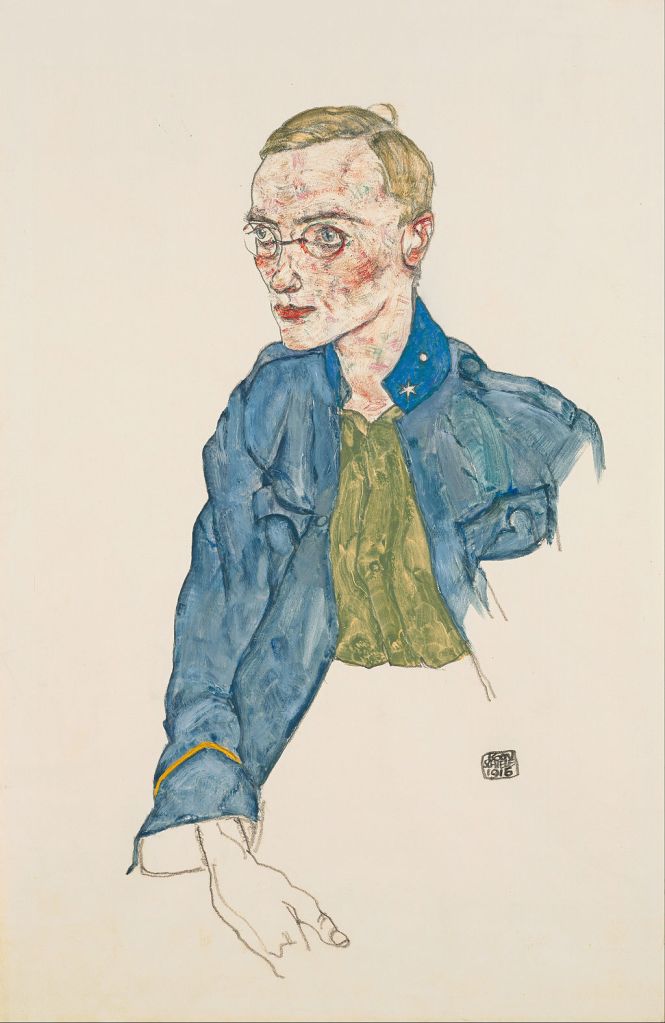Egon Schiele was a figurative artist from Austria. Egon Schiele painted portraits in an expressionist style which meant he tried to show feelings through his work, rather than trying to capture something realistic.
Top facts about Egon Schiele!
- Egon Schiele was born on 12 June 1890 and died on 31 October 1918
- Egon Schiele was a painter from Austria
- He died of Spanish flu, aged just 28 years old
- Despite being so young, he created over 3000 artworks on paper, and 300 paintings
- He is world famous and his paintings are known for being intense and raw
- Egon Schiele’s dad was a train station master, and Schiele was fascinated by trains as a young boy
- Schiele’s dad destroyed all of his early art sketchbooks
- He dropped out of art school after 3 years because he didn’t like the teacher’s artistic style
- During the war, Schiele guarded Russian prisoners… and painted them!
What type of painter was Egon Schiele?
Egon Schiele is described as an expressionist figurative painter. He painted a lot of portraits, but also created full body paintings showing the figures in unusual and dramatic positions. Expressionist painters like Egon Schiele were interested in creating a feeling, emotion or atmosphere in their work, rather than trying to create something scientifically realistic. Schiele is known for paintings that show twisted shapes and expressive, striking lines.


Looking at portrait paintings by Schiele, you may think they look strange and out of shape – and they are! Schiele’s main focus was to paint feelings or emotions. How do you think Schiele has managed to convey panic or fear in Self-Portrait with Raised Bare Shoulder, shown above? He has exaggerated his facial expression by making his eyebrows high and large, and widened his eyes to show fear. The brush strokes look like they have been applied quickly and create a harsh, textured finish.
“Art cannot be modern. Art is primordially eternal.”
Egon Schiele
How do you think Egon Schiele has kept a sense of realism in his paintings? Even though he used distorted shapes, jagged lines and exaggerated the facial features on his portrait paintings, Schiele often used a limited colour palette of muted tones to show skin and flesh. He also, mostly, kept the facial features in the correct place but would alter or change their size and shape.
How do you think Schiele has used composition to portray his confidence in the painting Self-Portrait with Striped Shirt?
In his paintings, Egon Schiele cleverly draws the viewer’s eye to the main focal point by using line and carefully thinking about his layout. In Self-Portrait with Striped Shirt Schiele has purposefully left out details on the shirt, apart from the shoulder line, which then draws our eye up to his face. The eyes are large and look directly back at the viewer and he has his head twisted towards us in a confident, powerful glare. There are other lines that direct our eyes too, look at the hair which is high and wide – the lines guide our eyes back down to the face.
Look closely at the colours Schiele has used above; the brightest colours are right in the middle of the painting! This is another clever technique used by the artist to make us look directly at the eyes. The warm red and orange tones used on the cheeks are complimented with a cool blue, directly below the eye, making the colours there appear more intense.
Watch the mini biography about Egon Schiele below – what other words do they use to describe his artwork? What are the most interesting facts about his life?
What do you think of Egon Schiele’s artwork? How could you describe it? Let me know in the comments! If you have found any of these resources useful please share this site on your networks / socials – thanks! 🙂
DOWNLOAD this page below, for free, as an Artist Research handout to use in your lesson. It includes all of the facts and images, and has questions for students to answer.







Very much on the point, love the comments and page set-up and design. Love it. Merci du Canada. Actually I have a few copy of drawings listed on Ebay under neenou. Obviously they are copies. but I liked them enough to purchase them. Richard.
LikeLiked by 1 person
Love this – thank you for sharing these posts! I know practically nothing “official” about art so I hope it’s OK to add a comment: I esp enjoyed your prompt above about how Schiele managed to convey panic or fear. The way he positioned the head matters a lot, too, I think. It seems to move, to pull away – “protected” by that raised shoulder. His heads are often tilted one way or another, sometimes in exaggerated ways that say a lot about how the person is feeling. I hope I’m not off-base with this – it’s just an observation. ———- I’m reading thru your posts, having a wonderful time learning. 🤗👋
LikeLiked by 1 person
So glad you are enjoying the site! And of course, all observations about art are valid – it’s one of the things I love about art 🙂
LikeLiked by 1 person